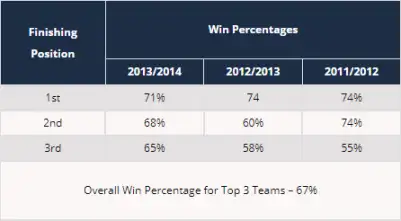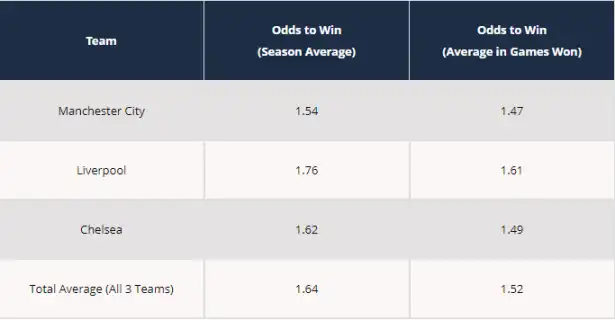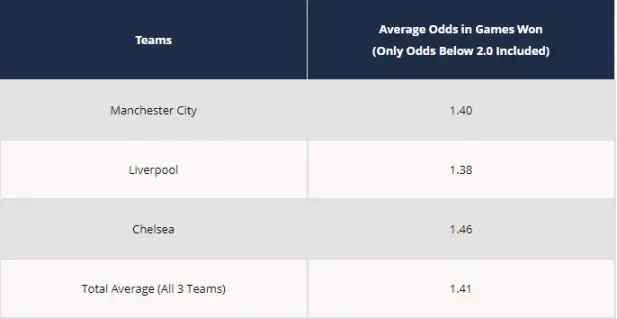Football Betting Strategy for Backing the Big Favorites
Is it a good strategy to always bet on the favorite?
Backing big favorites is a very popular strategy among soccer bettors. It’s incredibly straightforward, and it’s likely to return plenty of winners. These are two big advantages that bettors typically focus on.. But is this strategy TOO straightforward? Can we really expect to make money from such an obvious approach? If it was that easy, wouldn’t everyone be doing it?

Like most simple betting strategies, backing big favorites does have its flaws: it is based on some sound logic though. After all, big favorites are definitely expected to win more often than not. That’s precisely WHY they’re big favorites. It’s hardly unreasonable to assume that backing them will therefore be profitable in the long run.
The main flaw in this strategy is that the odds for big favorites to win are typically very low. This means you don’t stand to win much relative to your stake. This wouldn’t be a problem if you could rely on the favorites to win all the time, but we all know that upsets are common in soccer. A team could be destined to win but somehow end up either drawing or losing altogether.
That’s why the real question is this; do the big favorites win often enough to make this strategy profitable? This is an extremely difficult question to answer, partially because the term big favorite is too vague.
This highlights another flaw in the strategy. What exactly constitutes a big favorite? Different people will have different views on this. This means that the strategy is entirely open to interpretation, which is actually a good thing. Strategies that are based on following a precise system with no room for individual interpretation are usually doomed to failure. The best strategies are those that lay out some specific guidelines, but also involve making informed decisions in any given situation.
In this article we’re going to look at the backing big favorites strategy in detail. We start by analyzing the win rates of teams that are heavily favored to win, to see how often they meet expectations. Then we analyze the odds, to gain some real insight into how effective this strategy can be. With that information all in hand, we then provide our honest assessment of this strategy. Finally, we offer some advice for how it can be implemented most effectively through optimization.
Analyzing Win Rates of Big Favorites
The fundamental basis of this strategy is that big favorites do, in fact, win quite often. That’s also what makes it so appealing, as most bettors obviously like to win as many of their wagers as they can. HOW frequently do they win though? That’s something we really need to establish if we’re going to properly assess this strategy.
Let’s use some real data to try to answer this question. The English Premier League is widely considered the best soccer league in the world, and also attracts a lot of betting interest, so we’ll focus our attention here.
The following table shows the win percentage of each of the top three placed teams in this league over three consecutive season. As they ended up proving to be best teams in the league, it’s reasonable to assume that they would have been heavy favorites in most of the games they played.

We can see from this data that, collectively, the top three teams won 67% of the time across the three seasons. Had we backed each of these teams to win in every one of their games during this period, we would therefore have won 67% of our wagers. Or, to put it another way, we would have won roughly twice as many wagers as we’d have lost.
When looking just at the surface, this seems to be a very good success rate.
Don’t rush to start placing your wagers just yet though. Although this data does serve to back up the point that the big favorites win more often than they lose, it’s also far from being conclusive. It’s a very small sample size, and it reflects only one league. Also, we’re looking at results retrospectively. Prior to each season we couldn’t have actually known which teams were going to finish in the top three places.
Nevertheless, this data does go some way to proving that an advantage of backing big favorites is that you’re likely to win a high percentage of your wagers. For the majority of recreational bettors, this alone is a good enough reason to implement the strategy. When combined with the simplicity of the strategy, the case is even more compelling. Because this is exactly what most recreational bettors want: a simple strategy that will help them to win often.
Those serious about making money from betting soccer want just a little more though. They understand that a strategy is only beneficial if it helps to identify value in the betting markets. Win rates alone tell us nothing about value, so we also need to look at the odds.
Analyzing the Odds of Big Favorites
We’ve already mentioned that low odds of big favorites represent a flaw in this strategy. Because you’ll only win small amounts relative to your stake, even just a small number of losing wagers can easily wipe out the profits from the winning wagers. We’ll demonstrate this point by again using past data from the English Premier League
In the 2013/2014 season, the average odds for the top three teams to win their matches were 1.64 (decimal odds). This is based across all of their matches, other than those where any of the three teams played each other.
We’ve already established that those top three teams recorded a collective 67% win rate across the season. If we know the win rate, and we know the average odds, we should be able to estimate what our returns would have been from backing those teams. Let’s work it out. Here’s what we know for sure.
The top three teams won 67% of their matches between them.
Excluding matches against each other, each team played 34 matches.
Backing each of the top three teams in every game, except against each other, would have meant a total of 102 wagers (3 teams x 34 matches).
At a 67% win rate, we’d have won 68 of those wagers.
OK, so we’d have made 102 wagers and won 68 of them. That seems pretty good. Let’s see what this would have meant in real financial terms if we were betting $100 each time.
102 wagers at $100 each is a total of $10,200.
A $100 wager at 1.64 returns $164.
68 successful wagers at those odds returns $11,152
The total return minus the total staked is $952.
According to these figures we’d have made a profit of $952. Not too bad, or so it seems. The signs are pointing towards this strategy working well. However, the calculation we’ve used here are still not quite accurate enough. Combining the average odds across the season with average win rates might seem like a good way to calculate expected return, but it actually skews the real data somewhat.
Consider this. The teams did lose some of their games, and it’s likely that those losses came mostly against reasonably strong opponents. When they were up against strong opponents, the odds for them to win would have been higher than their average odds to win across the whole season. So we need to look at the numbers more closely. If these teams were losing games when their odds were higher, that means the average odds when they did win were probably lower than the average odds for the whole season.
To confirm this either way, let’s look at the data for the 2013/2014 season in a little more detail. The top three teams were Manchester City, Liverpool and Chelsea. The following table shows their average odds to win across the whole season, along with their average odds to win in games that they did win. It also shows the total averages across all three teams.

This confirms our suspicions. We can see from this table that the average odds across the whole season were indeed higher than the average odds in matches won. For all three of the teams collectively, the average odds when they did win come out at 1.52. This is noticeably lower than then 1.64 we used in our previous calculations. So we need to redo these calculations, and get a more accurate picture of our expected returns.
A $100 wager at 1.52 returns $152.
68 successful wagers at those odds returns $10,336
The total return minus the total staked is $136.
These figures show that we’d have actually done little better than break even. Suddenly this strategy doesn’t look quite so attractive. We still need to bear in mind that these are small sample. Some fluctuations either way are perfectly reasonable. So, at this stage, it’s not really possible to state categorically whether or not this would be a profitable strategy in the long run.
There’s also another problem with the data we’ve used so far. The top three teams that we’ve used for calculating these average odds were not always big favorites in every match. For example, Liverpool were 2.84 to beat Manchester United at Old Trafford during the season in question. They did win, but if we were only backing big favorites then we wouldn’t have placed the bet at those odds. The necessary criteria wasn’t met.
So we need to fine tune the data even further. We need to exclude the odds from any matches where the relevant teams were not big favorites. First we need to decide what constitutes a big favorite, as this isn’t a precise term. For now, we’ll assume that the strategy is to place a wager any time the odds are at less than 2.00
The following table shows the average odds based on these new parameters.

We can see that the average odds have dropped even further now. How do the expected returns look now, using this new adjusted average?
A $100 wager at 1.41 returns $141.
68 successful wagers at those odds returns $9,588
The total return minus the total staked is -$612.
These figures paint a totally different picture. Despite the attractive looking win rate of 67%, we’d have actually LOST money with this strategy. Not an insignificant amount either. We’d have lost around 6% of our total money staked.
The obvious conclusion now is that this strategy doesn’t work in its current form. But, again, let’s not be too hasty. Before we draw our own conclusions, we’d like to highlight a key point that you should take away from what we’ve learned so far.
If you are going to analyze data to help you make betting decisions, you have to make sure you are looking at the data in the right way.
This whole process has shown that it would be very easy to present past soccer betting data in a way that would lead us to believe this strategy could offer a positive expected return. It has also shown us that the expected return became very different once we adjusted the relevant data to more appropriate parameters.
This is a VERY important lesson to learn if you have aspirations of betting on soccer (or any sport) successfully. Statistical analysis can be very useful, but it has to be done correctly. There’s no point in using real data if you don’t use it in the right way. The conclusions you end up drawing are likely to be more damaging than valuable.
With this point made, it’s time to provide a full assessment of this strategy.
Assessing this Strategy
The purpose of the exercise we’ve just carried out was to determine whether or not backing big favorites is a good soccer betting strategy. The analysis we’ve done suggests that it isn’t, as it probably would lose us money over time. However, have we done enough to prove that it DEFINITELY doesn’t work? No, not at all. We simple haven’t analyzed enough data. We’d need a much bigger sample size if we wanted to categorically prove anything.
However, what we have done is properly highlight both the primary advantage and the primary disadvantage of this strategy. We’ve shown that you can achieve a high win rate with it. That’s a good thing, in isolation of other factors. We’ve also shown that the low odds mean that the returns from winning wagers are unlikely to make up for the losses on losing wagers. That’s obviously a bad thing.
What we really wanted to achieve here was a demonstration of how such a simple betting strategy is bound to be flawed. It’s important to understand that successful sports betting is rarely so straightforward. If making money from soccer betting was as easy as betting on every team that’s a big favorite, there’d be a lot of bookmakers out of work. The same principle applies to any strategy based on such a simple premise.
However, that’s not to say that simple strategies can’t be effective. They absolutely can be, if they’re interpreted correctly. We’ll expand on this point further shortly. Before that, here’s our rating for this strategy.

